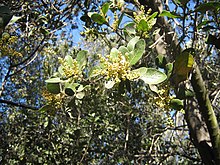| Lithraea caustica | |
|---|---|

| |
| Scientific classification | |
| Kingdom: | Plantae |
| Clade: | Tracheophytes |
| Clade: | Angiosperms |
| Clade: | Eudicots |
| Clade: | Rosids |
| Order: | Sapindales |
| Family: | Anacardiaceae |
| Genus: | Lithraea |
| Species: | L. caustica |
| Binomial name | |
| Lithraea caustica Hook. & Arn. | |
Lithraea caustica (commonly known as the litre tree, and historically as llithi or liti) is a species of flowering plants in the soapberry family Anacardiaceae. This plant is endemic to central Chile; an example occurrence is in the area of La Campana National Park and Cerro La Campana. The tree is a well known human allergen and can cause a rash of the skin, the effects of and susceptibility to which can vary greatly among individuals.
Description
Litre is evergreen, with oval leaves with a smooth or undulating border. It can grow to be a full tree when undisturbed; the tree-like formation was formerly common, but it is now most frequently found as a shrub due to changing patterns of land use. It has leathery leaves due to the high levels of lignin and cellulose. It grows large, underground burls from which new growth will emerge after it is cut or burned down; it shares this trait with most of the woody plants in its region.
Toxicology
The leaves and branches of litre induces severe dermatitis after contact with human skin. The dermatitis characterized by swelling and itching in some people. The allergenic agent of litre is 3–pentadecyl (10–enyl) catechol (litreol), an urushiol similar in structure to the allergens from poison oak and poison ivy.
Ecology
Litre grows in matorral climates (i.e., areas with similar climates to the southern Mediterranean); its range in Central Chile is the broadest of any matorral shrub in the region. It has been found to increase in abundance in response to grazing.
The plant propagates through the dispersal of seedlings. Instrumental in this dispersal are both birds (Turdus falklandii, Mimus thenca, Phytotoma rara) and foxes (Pseudalopex spp.)
It is drought resistant, due to its deep and extensive root system.
Probably due to its toxicity, litre is one of the least disturbed plants in its habitats. The plant and its surrounding soil have been found to be home to 29 families, 57 genera and 69 species of beetles.
Scientific History
Litre has been described in the scientific literature since at least the early 18th century. Explorer and botanist Louis Feuillée reported that sailors on his expedition experienced severe reactions after cutting down some 'Llithi' trees. It was given its first binomial name, Laurus caustica, by William Jackson Hooker and George Arnott Walker-Arnott in 1832.
References
- Wagstaff, D. Jesse (2008-07-07). International Poisonous Plants Checklist: An Evidence-Based Reference. CRC Press. ISBN 9781420062533.
- ^ Sprague, T. A. (1921). "Plant Dermatitis". Journal of Botany. 59: 308–310.
- Hogan, C. Michael (2012-10-17). "Chilean Wine Palm (Jubaea chilensis ) - photo/images/information - GlobalTwitcher.com". Archived from the original on 2012-10-17. Retrieved 2018-11-28.
- ^ Dallman, Peter R. (1998). Plant Life in the World's Mediterranean Climates: California, Chile, South Africa, Australia, and the Mediterranean Basin. University of California Press. ISBN 9780520208094.
- ^ Fuentes, Eduardo R; Muñoz, Mauricio R. (1995). "The Human Role in Changing Landscapes in Central Chile: Implications for Intercontinental Comparisons". Ecology and biogeography of Mediterranean ecosystems in Chile, California, and Australia. Kalin Arroyo, Mary T., Zedler, Paul H., Fox, Marilyn D. New York: Springer-Verlag. pp. 401–417. ISBN 978-0387942667. OCLC 29846995.
- ^ Keeley, Jon E. (1995). "Seed-Germination Patterns in Fire-Prone Mediterranean-Climate Regions". Ecology and biogeography of Mediterranean ecosystems in Chile, California, and Australia. Kalin Arroyo, Mary T., Zedler, Paul H., Fox, Marilyn D. New York: Springer-Verlag. pp. 239–273. ISBN 978-0387942667. OCLC 29846995.
- Kalergis, Alexis M.; López, Carolina B.; Becker, Maria I.; Diaz, Marisol I.; Sein, Jorge; Garbarino, Juan A.; De Ioannes, Alfredo E. (January 1997). "Modulation of Fatty Acid Oxidation Alters Contact Hypersensitivity to Urushiols: Role of Aliphatic Chain β-Oxidation in Processing and Activation of Urushiols". Journal of Investigative Dermatology. 108 (1): 57–61. doi:10.1111/1523-1747.ep12285632. ISSN 0022-202X. PMID 8980288.
- López, Carolina B.; Kalergis, Alexis M.; Becker, María Inés; Garbarino, Juan A.; De Ioannes, Alfredo E. (1998). "CD8+ T Cells Are the Effectors of the Contact Dermatitis Induced by Urushiol in Mice and Are Regulated by CD4+ T Cells". International Archives of Allergy and Immunology. 117 (3): 194–201. doi:10.1159/000024010. ISSN 1018-2438. PMID 9831807. S2CID 22723837.
- Hoffman, Alicia J.; Armesto, Juan J. (1995). Ecology and biogeography of Mediterranean ecosystems in Chile, California, and Australia. Kalin Arroyo, Mary T., Zedler, Paul H., Fox, Marilyn D. New York: Springer-Verlag. pp. 289–310. ISBN 978-0387942667. OCLC 29846995.
- Jaksi, F. M.; Schlatter, R. P.; Yanez, J. L. (1980-05-20). "Feeding Ecology of Central Chilean Foxes, Dusicyon culpaeus and Dusicyon griseus". Journal of Mammalogy. 61 (2): 254–260. doi:10.2307/1380046. ISSN 1545-1542. JSTOR 1380046. S2CID 85295803.
- Canadell, Josep; Zedler, Paul H. (1995). "Underground Structures of Woody Plants in Mediterranean Ecosystems of Australia, California, and Chile". Ecology and biogeography of Mediterranean ecosystems in Chile, California, and Australia. Kalin Arroyo, Mary T., Zedler, Paul H., Fox, Marilyn D. New York: Springer-Verlag. pp. 177–210. ISBN 978-0387942667. OCLC 29846995.
- Briones, Raúl; Jerez, Viviane; Bemítez, Hugo (2013). "Vertical Diversity of Beetles (Insecta: Coleoptera) Associated with Lithraea caustica (Anacardiaceae) in Patches of Sclerophyllous Forest in Central Chile". Journal of the Entomological Research Society. 15 (3): 41–52.
- Feuillée, Louis (1725). Journal des observations physiques, mathématiques et botaniques faites par ordre du roy sur les côtes orientales de l'Amérique méridionale de 1707 à 1712; Part II: Des Plantes Medecinales (in French). Paris: Jean Manette. pp. 33–34.
- Hooker, William Jackson; Walker Arnott, G. A. (1841). The Botany of Captain Beechey's voyage. p. 15. Retrieved 2018-12-07 – via Internet Archive.
External links
- [REDACTED] Media related to Lithrea caustica at Wikimedia Commons
- Feuillée's illustration via Google Books
| Taxon identifiers | |
|---|---|
| Lithraea caustica | |